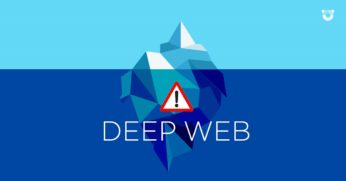
By: Genevieve deGuzman
The World Wide Web, or simply Web as we know it, actually only covers the surface of an ocean of information. The search engines we use, like Google and Bing, only float on the surface and cast a short net that follow links or static pages between sites.[1] The apps, merchants, social media, news, etc. we access on a daily basis barely make up less than one percent of the actual Web content.[2] These comprise what is more aptly called the Surface Web: anything accessible through search engines.
Diving further down, we would find the databases and academic journals hidden behind private networks or standalone pages that connect to nothing at all and do not surface to the Web. These are still reasonably known. The Deep Web is anything inaccessible through search engines, and a study conducted in 2001 revealed that the Deep Web was approximately 400-500 times the size of the Surface Web.[3]
Within the Deep Web lies the Dark Web, which refers to a collection of secret websites “concealed to hide in plain sight or reside within a separate, but public layer of the standard internet.”[4] They can only be accessed using certain special software, like The Onion Router, more commonly known as Tor.[5] Tor not only allows its users to access these concealed sites but also allows websites to operate on “hidden services” by replacing it with a Tor-based web address; the only way to access a hidden service is to know the hidden service’s Tor-based address.[6] It thwarts traditional IP identification and investigative techniques by masking a user’s IP address and its administrator’s identity.[7] Using Tor would render a user’s web activity as practically untraceable by bouncing signals around a “distributed network of relay computers” run by Tor-enabled volunteer computers around the world.[8]
Tor not only allows anonymous communication online for sensitive information, but more recently, Tor has become a “hub for black markets that sell or distribute drugs, [weapons, and people,] stolen credit cards, illegal pornography, pirated media,” assassins for hire, political dissidents, and more.[9] Tor is accessible and available to the public for free by downloading the Tor browser bundle.[10]
Tor effectively renders users anonymous to websites and to law enforcement officers who may be monitoring websites. However, Tor administrators claim that they are not aware of anyone being sued or prosecuted in the United States for using Tor.[11] Further, they believe it is legal under United States law.[12] Although it may be used for illegal purposes, Tor asserts that it was developed as a “tool for free expression, privacy, and human rights.”[13] Still, these Tor relays may still be subject to U.S. laws such as the Electronic Communications Privacy Act of 1986[14] which extends government restrictions on wire taps on telephone calls to include transmissions of electronic data via computers. Using Tor may not be illegal nor is merely masking one’s IP address and browsing history and activity, but as its anonymity tools are increasingly used for illegal activity, it may become more of an issue. Tor and other Dark Web tools are almost certain to gain more exposure and popularity, and with its increase in usage will come an increase in legal concerns and action. That said, you can expect the Dark Web to be an increasingly relevant factor for U.S. lawmakers to consider.
[1] See Jose Pagliery, The Deep Web you don’t know about, CNN, Mar. 10, 2013, available at http://money.cnn.com/2014/03/10/technology/deep-web/index.html.
[2] Id.
[3] Bright Planet, Understanding the Deep Web in 10 Minutes (2013), available at http://cdn2.hubspot.net/hub/179268/file-377288418-pdf/docs/understandingthedeepweb_20130311.pdf?t=1476906418725.
[4] Id.
[5] Id.
[6] See id; see also United States v. Werdene, No. 15-434, 2016 U.S. Dist. LEXIS 66311 (E.D. Pa. May 18, 2016)
[7] Id. See also United States v. Johnson, No. 15-00340-01-CR-W-GAF, 2016 U.S. Dist. LEXIS 145180 (W.D. Mo. Oct. 20, 2016).
[8] Id.
[9] Supra note 3.
[10] Id. See also Tor, https://www.torproject.org/ (last visited Oct. 20, 2016).
[11] Tor, https://www.torproject.org/ (last visited Oct. 20, 2016).
[12] Id.
[13] Id.
[14] Electronic Communication Privacy Act of 1986, 100 Stat. 1848.
Photo Source:
http://www.pandasecurity.com/mediacenter/src/uploads/2016/06/deepweb1.jpg
